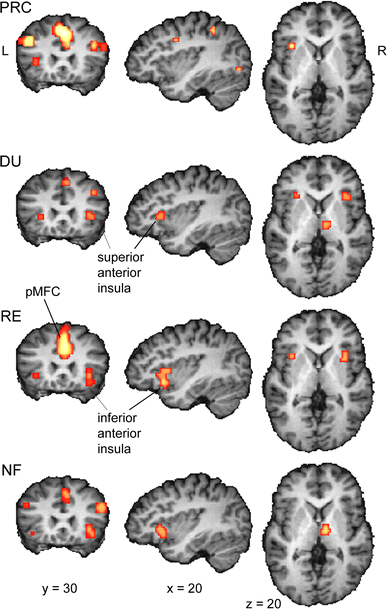Conscious perception of errors and its relation to the anterior insula
- PMID: 20512371
- PMCID: PMC2886909
- DOI: 10.1007/s00429-010-0261-1
Conscious perception of errors and its relation to the anterior insula
Abstract
To detect erroneous action outcomes is necessary for flexible adjustments and therefore a prerequisite of adaptive, goal-directed behavior. While performance monitoring has been studied intensively over two decades and a vast amount of knowledge on its functional neuroanatomy has been gathered, much less is known about conscious error perception, often referred to as error awareness. Here, we review and discuss the conditions under which error awareness occurs, its neural correlates and underlying functional neuroanatomy. We focus specifically on the anterior insula, which has been shown to be (a) reliably activated during performance monitoring and (b) modulated by error awareness. Anterior insular activity appears to be closely related to autonomic responses associated with consciously perceived errors, although the causality and directions of these relationships still needs to be unraveled. We discuss the role of the anterior insula in generating versus perceiving autonomic responses and as a key player in balancing effortful task-related and resting-state activity. We suggest that errors elicit reactions highly reminiscent of an orienting response and may thus induce the autonomic arousal needed to recruit the required mental and physical resources. We discuss the role of norepinephrine activity in eliciting sufficiently strong central and autonomic nervous responses enabling the necessary adaptation as well as conscious error perception.
Figures




Similar articles
-
Error blindness and motivational significance: Shifts in networks centering on anterior insula co-vary with error awareness and pupil dilation.Behav Brain Res. 2018 Dec 14;355:24-35. doi: 10.1016/j.bbr.2017.10.030. Epub 2017 Oct 26. Behav Brain Res. 2018. PMID: 29107022
-
Conjoint activity of anterior insular and anterior cingulate cortex: awareness and response.Brain Struct Funct. 2010 Jun;214(5-6):535-49. doi: 10.1007/s00429-010-0265-x. Epub 2010 May 29. Brain Struct Funct. 2010. PMID: 20512367 Free PMC article. Review.
-
Risk and risk prediction error signals in anterior insula.Brain Struct Funct. 2010 Jun;214(5-6):645-53. doi: 10.1007/s00429-010-0253-1. Epub 2010 May 29. Brain Struct Funct. 2010. PMID: 20512378 Review.
-
Fear conditioning in humans: the influence of awareness and autonomic arousal on functional neuroanatomy.Neuron. 2002 Feb 14;33(4):653-63. doi: 10.1016/s0896-6273(02)00588-3. Neuron. 2002. PMID: 11856537
-
Awareness is required for autonomic performance monitoring in instrumental learning: Evidence from cardiac activity.Psychophysiology. 2022 Sep;59(9):e14047. doi: 10.1111/psyp.14047. Epub 2022 Mar 18. Psychophysiology. 2022. PMID: 35304762 Free PMC article.
Cited by
-
Causal Interactions Within a Frontal-Cingulate-Parietal Network During Cognitive Control: Convergent Evidence from a Multisite-Multitask Investigation.Cereb Cortex. 2016 May;26(5):2140-53. doi: 10.1093/cercor/bhv046. Epub 2015 Mar 15. Cereb Cortex. 2016. PMID: 25778346 Free PMC article.
-
A perspective on neural and cognitive mechanisms of error commission.Front Behav Neurosci. 2015 Mar 3;9:50. doi: 10.3389/fnbeh.2015.00050. eCollection 2015. Front Behav Neurosci. 2015. PMID: 25784865 Free PMC article. Review.
-
Frontoinsular cortical microstructure is linked to life satisfaction in young adulthood.Brain Imaging Behav. 2021 Dec;15(6):2775-2789. doi: 10.1007/s11682-021-00467-y. Epub 2021 Apr 6. Brain Imaging Behav. 2021. PMID: 33825124 Free PMC article.
-
Structural connectivity profile supports laterality of the salience network.Hum Brain Mapp. 2019 Dec 15;40(18):5242-5255. doi: 10.1002/hbm.24769. Epub 2019 Aug 21. Hum Brain Mapp. 2019. PMID: 31436006 Free PMC article.
-
Poor awareness of IADL deficits is associated with reduced regional brain volume in older adults with cognitive impairment.Neuropsychologia. 2019 Jun;129:372-378. doi: 10.1016/j.neuropsychologia.2019.04.023. Epub 2019 May 4. Neuropsychologia. 2019. PMID: 31059694 Free PMC article.
References
-
- Allain S, Hasbroucq T, Burle B, Grapperon J, Vidal F. Response monitoring without sensory feedback. Clin Neurophysiol. 2004;115:2014–2020. - PubMed
-
- Aston-Jones G, Cohen JD. An integrative theory of locus coeruleus–norepinephrine function: adaptive gain and optimal performance. Annu Rev Neurosci. 2005;28:403–450. - PubMed
-
- Aston-Jones G, Ennis M, Pieribone VA, Nickell WT, Shipley MT. The brain nucleus locus coeruleus: restricted afferent control of a broad efferent network. Science. 1986;234:734–737. - PubMed
-
- Aston-Jones G, Shipley MT, Chouvet G, Ennis M, van Bockstaele E, Pieribone V, Shiekhattar R, Akaoka H, Drolet G, Astier B, et al. Afferent regulation of locus coeruleus neurons: anatomy, physiology and pharmacology. Prog Brain Res. 1991;88:47–75. - PubMed
-
- Augustine JR. Circuitry and functional aspects of the insular lobe in primates including humans. Brain Res Brain Res Rev. 1996;22:229–244. - PubMed
Publication types
MeSH terms
LinkOut - more resources
Full Text Sources
Other Literature Sources

